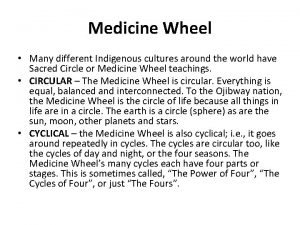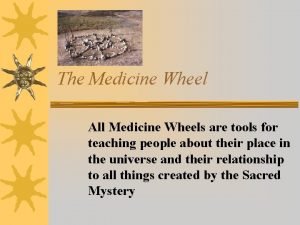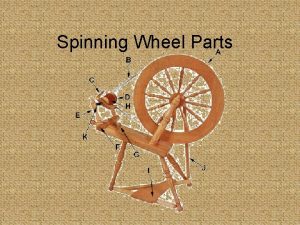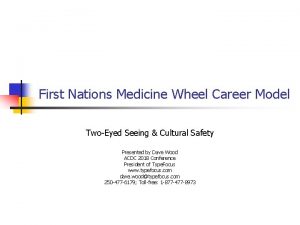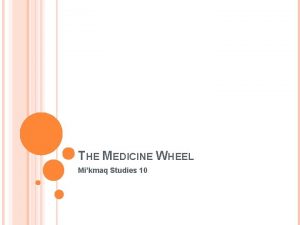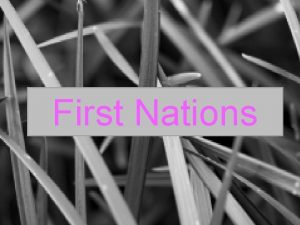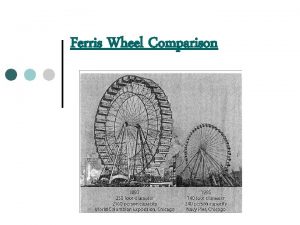Topic 3 The needs First nations Medicine wheel












































- Slides: 44

Topic 3 The needs!

First nations “Medicine wheel”

Maslow’s Hierarchy of Needs

Goleman’s Emotional Tasks • Be aware of our feelings. • Understand our feelings. • Control our feelings. • Read other people. • Resolve conflict.

Relatedness Competence Deci & Ryan Autonomy Love Glasser S Fun Belonging Generosity Power Freedom Mastery Independence First Nations

Tony Robbins 6 needs Most people keeps their problem because it meets their needs Fundamental needs • • Certainty – avoid pain, Uncertainty - variety Significance – importance, unique Connection – love Needs of the spirit • • Growth – need of the spirit Contribution

Diane’s Circle of needs Belonging Power Survival Fun Freedom

Our basic needs! • • Security – food, shelter, safety Love – belonging, friendship, caring Power – importance, recognition, caring Fun –pleasure, enjoyment, learning, laughter • Freedom – choice, independence, liberty

FIVE BASIC NEEDS Excerpted from Restitution Basics by Anne O’Brien

Belonging • Wants to be liked • Very sociable • Works hard for other’s approval. • Peers are important • Enjoys activities that are cooperative

Applying Needs in Your Class Belonging • • Profile Wants to be liked. Very sociable Works hard for others approval • Peers and important • Enjoys cooperative activities • Procedures • Greet students at the door. • Learn their names ASAP • Acknowledge special events like birthdays • Take an interest in their personal lives • Tell them about your life outside school. (Movies, TV, music, vacations)

Belonging Behaviors • • • Accepting Compliments Friendship Trust Self Assurance Outgoing • • Being With People Harmonizing Giving Helping Sharing Approachable Open

Belonging Circle

Power • Wants to be in control • Observes before trying new things • Distressed by mistakes • Very organized, systematic • Likes to be the best

Power • Profile • Wants to be in control • Observes before trying new things • Distressed by mistakes • Very organized, systematic • Likes to be the best • Procedures • Give opportunity for students to express themselves. • Assign duties in the class. • Give opportunities to show mastery. • Teach them that its ok to make mistake

Power Behavior • • Looking for positives Displaying confidence Knowing who you are Making your own decisions • Helping others • Feeling equal to others • Solving problems • Being in control of yourself • Taking control of a situation • Directness • Accepting different roles • Not doing more than you should POWER DEFINITION The ability to create and maintain an impact on the world

SIX KINDS OF POWER – We can impact on: OUR OWN BODIES Negative Positive anorexia/bulimia grooming/self/makeup slashing exercising/dieting drug use learning a language or new skill THE INANIMATE WORLD Negative Positive steal a car clean the house vandalize build something or complete a project INFLUENCING OTHER PEOPLE Negative Positive angering smiling guilting complimenting whining encouraging ignoring loving/caring sarcasm listening sighing touching depressing sexual contact People recognize all of the negative influencing behavior as controlling but too often fail to recognize the positive influence behaviors as controlling too.

Fun • • Wants to enjoy work Amusing even when misbehaving Collectors: Love games Jokester; Clowns around

Fun • Profile Wants to enjoy work • Amusing even when misbehaving • Collectors. Loves games • Jokester; clowns around • • Procedures Play games in class Do “review BINGO” Play “Millionaire” or “Jeopardy”

Fun Behaviors • • Laughing Creating Smiling Happiness Helping others Accepting reality Not worrying Making the most of a situation • Varied interests • • Natural highs Enjoys little things Sense of humor Not taking things for granted • Full of energy • Taking life as it comes • Having fun in whatever you are doing at the time

THIS IS FUN Looks Like Sounds Like THIS IS NOT FUN Looks Like Sounds Like

Freedom • • • Wants choices Needs to move around Loves to experiment Not so influenced by others Tries anything new and engaging

Freedom • • Profile Want choices Need to move around Loves to explore and experiment • Not so influenced by others • Tries anything new and engaging • Procedures • Give students choice of where they sit. • Let them choose to work with others or alone. • Get them to help create evaluations • Help them to selfevaluate • Give opportunities to move around.

Freedom Behaviors • Making your own decisions • Exploring new opportunities • Uniqueness • Risk taking • Tolerant • Open • Positive • Expressing feelings • Liking and knowing yourself • Acting instead of dreaming • Living in the moment • Doing what you want

Two Kinds of Freedom FREEDOM TO I might get more of what I want if I gave myself permission to: ACT__________ THINK_________ FEEL_________ PHYSICALLY______ FREEDOM FROM I might have more freedom if I let myself be less controlled by: ___________________ I might have more freedom if I felt less responsible for: ____________________

Survival • • Food Shelter Sleep Wellness

Power I’m like this at home! Belonging Fun Freedom

Power I’m like this at work! Belonging Fun Freedom

Power This is me in sport! Belonging Fun Freedom

Power How are you? Belonging Fun Freedom at home, in school, with friends, at work ……. .

How am I behaving? Am I asking the impossible? Am I acting in a caring way? Can I see it from another point of view? Is it my job to interfere? Does it really matter. . . whether it is done? . . . how it is done? . . . when it is done?

Ask you this questions! • What kind of relationship do I want with this person? • What am I doing to get this relationship? • Is what I'm doing working to get me the kind of relationship I want?

Eight Basic Principles of self-discipline: 1. 2. 3. 4. 5. 6. 7. 8. Everyone makes mistakes People know when they’ve done wrong Guilt and criticism contribute to defensive behavior People can learn a better way Children are strengthened by the opportunity to make amends They won’t lie to hide their mistakes The process of learning self-discipline is a creative one People who have been allowed to make restitution become more generous with others.

BASIC NEEDS


APPLICATION OF NEEDS THEORY • Genetic intensity—Identify your largest need. • A difficult decision? Use the needs. • Analyze a relationship you’ve left using the needs. • Analyze an activity you enjoy using the needs. • Analyze your job using the needs. • Analyze the way you dress using the needs. • Analyze the vehicle you drive using the needs. • Analyze a class/course using the needs. • Analyze a friendship/relationship dynamic using the needs. • Analyze a staff meeting using the needs.

How To Teach The Needs 1. Teach the needs. – Love, Power, Freedom, Fun, Survival (Glasser) – Relatedness, Competence, Autonomy (Deci & Ryan) – Medicine Wheel - Belonging, Mastery, Independence, Generosity 2. Have them fill out the four quadrants and share. 3. Identify activities that meet all their needs. 4. Identify areas that are more empty or more full. – Think of a totally need satisfying relationship you have. – Think of a relationship or job you left. What need/needs were not met. – Brainstorm how to have a more need satisfying classroom/workplace. 5. Teach genetic intensity of the needs.

Genetic Intensity of the Needs Fill in the circle above a number on the continuum to rate the strength of each need as you perceive it to be: SURVIVAL BELONGING LOW 1 4 2 3 4 5 HIGH 2 3 4 LOW 1 5 HIGH LOW 1 FUN 3 LOW 1 FREEDOM 2 LOW 1 POWER HIGH 5 HIGH 2 3 4 5 PROFILE FROM ABOVE RECORD NUMBERS CIRCLED HERE First Name or Initials Survival Belonging Power Freedom Fun

Needs Are Individual Now I want you to think about your needs. Which one do you think is the strongest for you. We are all different. The strongest one is the one that hurts the most when we don’t get it. – – – – I think my biggest need is ___________. I think my sister’s biggest need is ________. I think my brother’s biggest need is _______. I think my mom’s biggest need is ________. I think my dad’s biggest need is _________. I think my relative’s biggest need is _______. I think my teacher’s biggest need is _______. Go home tonight and talk about this. See if you can explain it. It will be fun to see what your family thinks. Sometimes people use a hand to remember the needs. Excerpted from Resolving Conflict Using Restitution by Diane Gossen

Going from the Want to the Need • This exercise teaches that we have many wants for each need and that the system is flexible. Have each participant choose a want that they have which they can't get right now. It must be a true want in order for there to be energy in it. • What do you want? What do you really want? • What does it mean? What need would be met if you got what you wanted? Can you get what you want right now? (The answer should be "no". If the answer is "yes" the person should pick something else that they can't get right now. ) • If the answer is "no, " then the helper asks, "Is this need (love, power, fun, freedom) important to you? Do you still need to meet it? (self-evaluation)

IF THE ANSWER IS “YES” • If the answer is "yes, " then say, "You can't always get what you want, but you can get some of what you need, so let's get at it. " • Help the person fill alternative wants circles which help meet the presented need. • Be sure that at least one of the alternate circles is conflicted (ie. is antithetical to the person's value system). Teach them that if the need is not met the system keeps behaving to get what is needed, and when frustrated, that system is amoral. (For example, the woman who woke up one morning presented with the thought, "This marriage would work better if I were an invalid. " That picture is one that though moderately need-fulfilling in one area is basically negative in terms of survival). • Application: This is especially effective with someone who has been "spinning his wheels" on one want (e. g. "I want him to love") and refusing to add new pictures to they system. Here it is important to say, "You'll always want what you want (e. g. that your husband were alive), however, you still have to meet your needs today, in this world. "

YOU CAN'T ALWAYS GET WHAT YOU WANT BUT YOU CAN GET SOME OF WHAT YOU NEED

What’s It Getting You? The Needs Behind Misbehavior • 1) “What were you trying to get by (name the behavior) Tapping pencil, hitting, swearing • Alternative: “What were you avoiding by _____” • 2) Find the need. Listen for statement for the need. • a) If you hear a need ask tray. b) If you get a “I don’t know” pass the needs Behavior Hitting Disruptive Tripping Kicked What it was getting Stand up for self “Off my case” “Have some fun. ” “Be my friend” Need Power Freedom Fun Love 3) STATE: “Should I tell you not to ( __Meet your need__)? “ Child answers: NO 4) STATE; “I agree with you. ” 5) ASK: “Is there a way that you can (meet your need) without getting into trouble? ”

Collapsing Conflict Wants Needs
 Native colour wheel
Native colour wheel Primary needs and secondary needs
Primary needs and secondary needs Satisfaction
Satisfaction Simple claustral complex
Simple claustral complex Strategic gender needs and practical gender needs
Strategic gender needs and practical gender needs Present situation analysis
Present situation analysis Wheel
Wheel Medicine wheel colors
Medicine wheel colors Iroquois medicine wheel
Iroquois medicine wheel Medicine wheel essay
Medicine wheel essay Chris drury medicine wheel
Chris drury medicine wheel Integrative medicine wheel
Integrative medicine wheel Medicine wheel clones
Medicine wheel clones Sleep center cleveland clinic
Sleep center cleveland clinic Medicine wheel lakota
Medicine wheel lakota What is a clincher sentence
What is a clincher sentence Topic about internet
Topic about internet Tire wheel and wheel bearing fundamentals
Tire wheel and wheel bearing fundamentals Chapter 73 tire wheel and wheel bearing fundamentals
Chapter 73 tire wheel and wheel bearing fundamentals It is a slender tool attached in the needle
It is a slender tool attached in the needle Indigenous wellness framework
Indigenous wellness framework First nations launch
First nations launch First nations attack fort michilimackinac 1763
First nations attack fort michilimackinac 1763 Simple machines used by first nations
Simple machines used by first nations First nations education administrators association
First nations education administrators association Niawen'kó wa
Niawen'kó wa Janice ciavaglia
Janice ciavaglia First nations alphabet
First nations alphabet Hát kết hợp bộ gõ cơ thể
Hát kết hợp bộ gõ cơ thể Frameset trong html5
Frameset trong html5 Bổ thể
Bổ thể Tỉ lệ cơ thể trẻ em
Tỉ lệ cơ thể trẻ em Voi kéo gỗ như thế nào
Voi kéo gỗ như thế nào Thang điểm glasgow
Thang điểm glasgow Chúa yêu trần thế alleluia
Chúa yêu trần thế alleluia Các môn thể thao bắt đầu bằng tiếng bóng
Các môn thể thao bắt đầu bằng tiếng bóng Thế nào là hệ số cao nhất
Thế nào là hệ số cao nhất Các châu lục và đại dương trên thế giới
Các châu lục và đại dương trên thế giới Cong thức tính động năng
Cong thức tính động năng Trời xanh đây là của chúng ta thể thơ
Trời xanh đây là của chúng ta thể thơ Cách giải mật thư tọa độ
Cách giải mật thư tọa độ 101012 bằng
101012 bằng Phản ứng thế ankan
Phản ứng thế ankan Các châu lục và đại dương trên thế giới
Các châu lục và đại dương trên thế giới Thơ thất ngôn tứ tuyệt đường luật
Thơ thất ngôn tứ tuyệt đường luật







